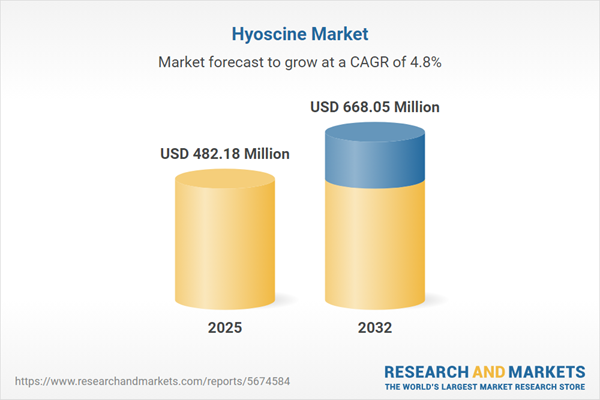Speak directly to the analyst to clarify any post sales queries you may have.
Hyoscine market decision-makers navigate a shifting global landscape marked by regulatory changes, evolving clinical use, and rapid technological progress. This report distills essential insights for executives seeking strategic direction, market leadership, and competitive resilience in a complex pharmaceutical environment.
Market Snapshot: Trends and Growth Dynamics in the Global Hyoscine Market
The global hyoscine market is expanding steadily, underpinned by sustained pharmaceutical innovation and the broadening role of hyoscine in clinical care. Growth is projected through 2032, with market participants adapting operations and investment strategies in response to evolving clinical standards. Companies focus on developing novel drug delivery formats to enhance therapeutic value, particularly for antiemetic and gastrointestinal indications. Manufacturers are optimizing research and commercialization pipelines to address new regulatory expectations and streamline time to market. The adoption of digital supply chain platforms and technology-driven business models is improving operational efficiency, while business plans increasingly take into account regional preferences and healthcare system variations. This adaptive market environment supports resilience and ongoing opportunity even as clinical and business demands continue to change.
Scope & Segmentation: Strategic Insights for Hyoscine Market Leaders
- Brand Type: Both branded and generic hyoscine options shape procurement decisions, pricing strategies, and the structure of partnerships across the pharmaceutical value chain.
- Application: Expanded use in gastrointestinal disorders and for motion sickness is driving the need for market strategies aligned with region-specific regulations and diverse patient profiles.
- End User: Hospitals, outpatient clinics, and home care providers each require tailored integration strategies to reflect unique workflows and care delivery models.
- Dosage Form: Injectable, oral tablet, and transdermal patch products enable flexible care approaches and address adherence challenges in both acute and chronic care scenarios.
- Distribution Channel: Market access is expanding through hospital pharmacies, retail outlets, and digital health platforms, allowing manufacturers to better reach providers and end users.
- Regions Covered: The Americas, Europe, Middle East & Africa, and Asia-Pacific bring diverse regulatory and clinical uptake trends; key reference points include the United States, China, Germany, and India for strategic market planning and localization.
- Major Companies Profiled: Leading organizations—Novartis AG, Teva Pharmaceutical Industries Ltd., Viatris Inc., Dr. Reddy’s Laboratories Ltd., Sun Pharmaceutical Industries Ltd., Hikma Pharmaceuticals PLC, Sandoz International GmbH, Glenmark Pharmaceuticals Ltd., Wockhardt Ltd., and Pfizer Inc.—demonstrate a range of operational priorities and research directions to sustain competitive differentiation.
Key Takeaways: Priority Strategies for Senior Hyoscine Market Decision-Makers
- Expand product lines in antiemetic and antispasmodic therapies to address global shifts in patient health needs and capitalize on demand from increasingly mobile populations.
- Implement advanced delivery technologies, such as transdermal patches and optimized oral formulations, to facilitate better medication adherence and support both home-based and community medical care.
- Engage with contract development and manufacturing partners to boost flexibility, respond promptly to ongoing regulatory updates, and accommodate dynamic demand cycles.
- Strengthen local supply chains and enhance in-market commercial presence in regions like Asia-Pacific and Middle East & Africa to better synchronize with local procurement dynamics and complex healthcare delivery models.
- Leverage digital health solutions and alternative distribution models to increase market access, enable technology-supported treatment, and improve internal efficiency.
- Commit to ongoing clinical research and maintain active collaboration with key healthcare stakeholders to ensure regulatory compliance and sustain market positioning.
Tariff Impact: Navigating Regulatory-Driven Sourcing Environments
Recent tariff changes in the United States prompt hyoscine manufacturers to reassess sourcing strategies and prioritize strengthening domestic production capabilities. By developing close partnerships with local suppliers and focusing on in-country manufacturing, firms can minimize supply interruptions and better absorb regulatory and market shifts, enhancing their agility and reliability.
Methodology & Data Sources
This report applies insights from executive interviews, validated end-user surveys, and comprehensive secondary research. The methodology evolves in line with updated regulatory frameworks and changes in intellectual property, ensuring current, decision-ready intelligence for hyoscine market stakeholders.
Why This Report Matters
- Provides senior leaders with a clear view of major hyoscine market drivers and emerging challenges, supporting better operational planning and resource allocation.
- Offers practical guidance to expand portfolios, build supply chain strength, and foster effective partnerships with commercial and clinical stakeholders.
- Equips organizations with proven frameworks for compliance and sourcing, supporting operational resilience and long-term positioning in a fluid market environment.
Conclusion
With innovation and adaptive business models at its core, the global hyoscine market continues to evolve in response to clinical and operational change. This analysis empowers executives to identify new opportunities and maintain steady performance in a rapidly shifting setting.
Additional Product Information:
- Purchase of this report includes 1 year online access with quarterly updates.
- This report can be updated on request. Please contact our Customer Experience team using the Ask a Question widget on our website.
Table of Contents
3. Executive Summary
4. Market Overview
7. Cumulative Impact of Artificial Intelligence 2025
Companies Mentioned
The companies profiled in this Hyoscine market report include:- Novartis AG
- Teva Pharmaceutical Industries Ltd.
- Viatris Inc.
- Dr. Reddy’s Laboratories Ltd.
- Sun Pharmaceutical Industries Ltd.
- Hikma Pharmaceuticals PLC
- Sandoz International GmbH
- Glenmark Pharmaceuticals Ltd.
- Wockhardt Ltd.
- Pfizer Inc.
Table Information
| Report Attribute | Details |
|---|---|
| No. of Pages | 180 |
| Published | October 2025 |
| Forecast Period | 2025 - 2032 |
| Estimated Market Value ( USD | $ 482.18 Million |
| Forecasted Market Value ( USD | $ 668.05 Million |
| Compound Annual Growth Rate | 4.7% |
| Regions Covered | Global |
| No. of Companies Mentioned | 11 |









